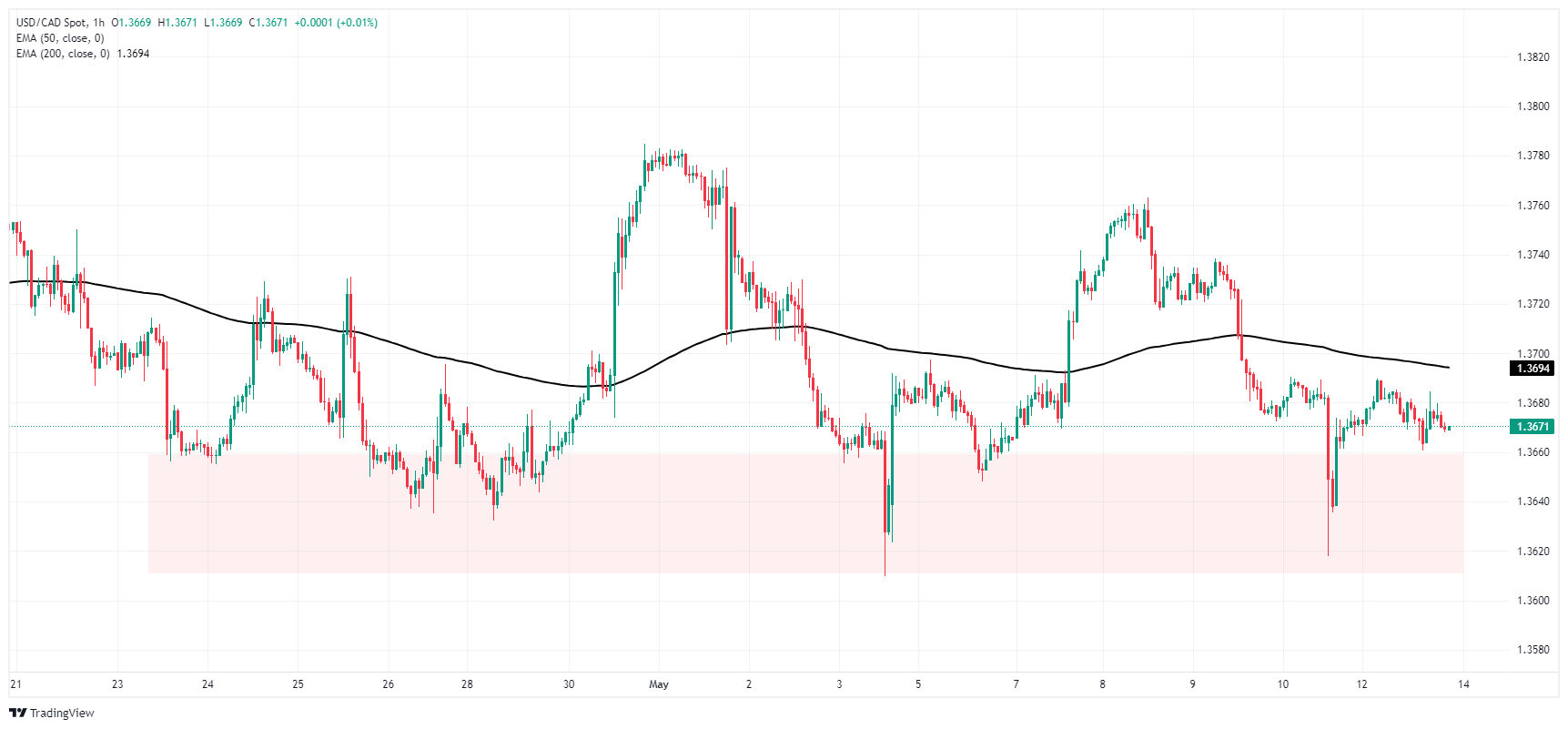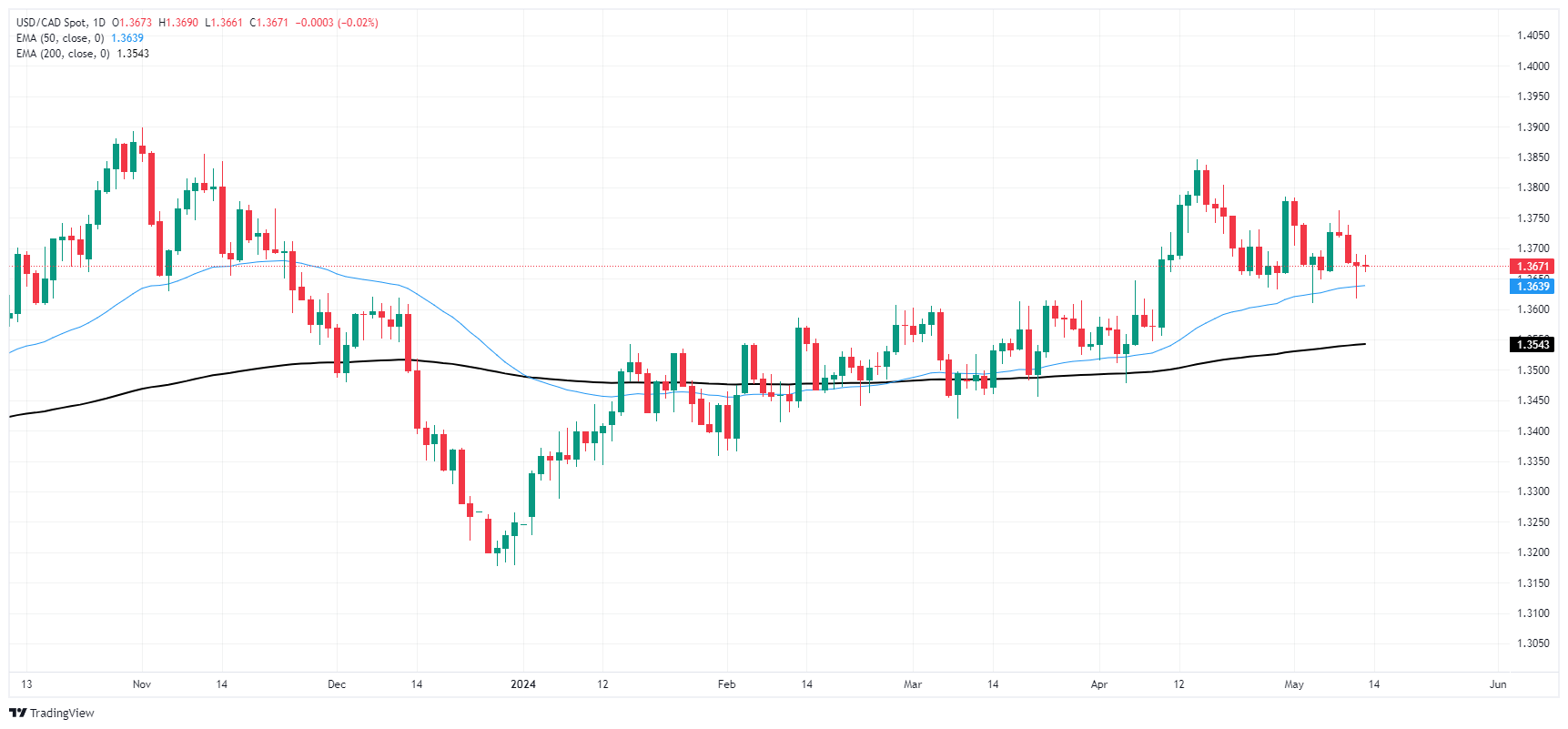Canadian Dollar treads water, stuck in the midrange on tepid Monday

- Canadian Dollar middles as markets focus on Fed rate cuts.
- Canada issued far fewer building permits than expected in March.
- Markets continue to bet on two rate cuts in 2024 despite cautionary Fedspeak.
The Canadian Dollar (CAD) churned within familiar levels on Monday as a data-light economic calendar kicks off the new trading week. Investors continue to hinge risk appetite on rate cut expectations from the Federal Reserve (Fed) with updates to US inflation data due later in the week.
Canada saw a sharper-than-expected decline in new Building Permits issued in March, but data from early in the housing cycle remains low-tier and limited-impact. Canadian economic data remains low-priority for the rest of the week, leaving market participants to focus on the US Producer Price Index (PPI) due on Tuesday, followed by US Consumer Price Index (CPI) inflation and Retail Sales on Wednesday.
Daily digest market movers: Canadian Dollar stuck in the middle as rate cut hopes dominate
- Canadian Building Permits issued in March declined -11.7%, far below the -4.6% forecast, the sharpest decline in MoM Building Permits since June of 2023. April’s Building Permits were also revised slightly lower to 8.9% from 9.3%.
- The latest Survey of Consumer Expectations from the New York Fed noted that surveyed consumers expect inflation to rise to 3.3% over the next year, higher than the previous survey’s 3.0%.
- A Reuters survey of 108 economists showed nearly two-thirds of respondents still expect a quarter-point cut from the Fed by September despite none expecting inflation to reach the Fed’s 2% target before 2026.
- YoY US Producer Price Index inflation is expected to rise to 2.2% on Tuesday, compared to the previous period’s 2.1%.
- Wednesday’s US CPI inflation print for April is forecast to hold steady at 0.4% MoM, with the YoY figure expected to tick down to 3.4% from 3.5%.
Canadian Dollar PRICE Today
The table below shows the percentage change of Canadian Dollar (CAD) against listed major currencies today. Canadian Dollar was the strongest against the British Pound.
| USD | EUR | GBP | JPY | CAD | AUD | NZD | CHF | |
|---|---|---|---|---|---|---|---|---|
| USD | 0.16% | 0.24% | -0.31% | -0.01% | 0.06% | -0.13% | -0.19% | |
| EUR | -0.16% | 0.13% | -0.47% | -0.16% | -0.06% | -0.26% | -0.34% | |
| GBP | -0.24% | -0.13% | -0.53% | -0.30% | -0.20% | -0.40% | -0.47% | |
| JPY | 0.31% | 0.47% | 0.53% | 0.33% | 0.34% | 0.23% | 0.08% | |
| CAD | 0.01% | 0.16% | 0.30% | -0.33% | 0.04% | -0.11% | -0.12% | |
| AUD | -0.06% | 0.06% | 0.20% | -0.34% | -0.04% | -0.09% | -0.28% | |
| NZD | 0.13% | 0.26% | 0.40% | -0.23% | 0.11% | 0.09% | -0.08% | |
| CHF | 0.19% | 0.34% | 0.47% | -0.08% | 0.12% | 0.28% | 0.08% |
The heat map shows percentage changes of major currencies against each other. The base currency is picked from the left column, while the quote currency is picked from the top row. For example, if you pick the Canadian Dollar from the left column and move along the horizontal line to the US Dollar, the percentage change displayed in the box will represent CAD (base)/USD (quote).
Technical analysis: Canadian Dollar middles as markets hold steady
The Canadian Dollar (CAD) traded tightly on Monday, stuck near the new trading week’s opening bids. The CAD is trading within a quarter of a percent against nearly all of its major currency peers on Monday and holding next to flat against the US Dollar (USD).
The USD/CAD struggled to find momentum on Monday, holding in place near 1.3680. Bids are treading water just above a near-term supply zone from 1.3660 to 1.3615. Topside momentum is capped by the 200-hour Exponential Moving Average (EMA) just below the 1.3700 handle, while short-sellers have been unsuccessful in dragging the pair back down to 1.3600.
USD/CAD hourly chart
USD/CAD daily chart
Canadian Dollar FAQs
The key factors driving the Canadian Dollar (CAD) are the level of interest rates set by the Bank of Canada (BoC), the price of Oil, Canada’s largest export, the health of its economy, inflation and the Trade Balance, which is the difference between the value of Canada’s exports versus its imports. Other factors include market sentiment – whether investors are taking on more risky assets (risk-on) or seeking safe-havens (risk-off) – with risk-on being CAD-positive. As its largest trading partner, the health of the US economy is also a key factor influencing the Canadian Dollar.
The Bank of Canada (BoC) has a significant influence on the Canadian Dollar by setting the level of interest rates that banks can lend to one another. This influences the level of interest rates for everyone. The main goal of the BoC is to maintain inflation at 1-3% by adjusting interest rates up or down. Relatively higher interest rates tend to be positive for the CAD. The Bank of Canada can also use quantitative easing and tightening to influence credit conditions, with the former CAD-negative and the latter CAD-positive.
The price of Oil is a key factor impacting the value of the Canadian Dollar. Petroleum is Canada’s biggest export, so Oil price tends to have an immediate impact on the CAD value. Generally, if Oil price rises CAD also goes up, as aggregate demand for the currency increases. The opposite is the case if the price of Oil falls. Higher Oil prices also tend to result in a greater likelihood of a positive Trade Balance, which is also supportive of the CAD.
While inflation had always traditionally been thought of as a negative factor for a currency since it lowers the value of money, the opposite has actually been the case in modern times with the relaxation of cross-border capital controls. Higher inflation tends to lead central banks to put up interest rates which attracts more capital inflows from global investors seeking a lucrative place to keep their money. This increases demand for the local currency, which in Canada’s case is the Canadian Dollar.
Macroeconomic data releases gauge the health of the economy and can have an impact on the Canadian Dollar. Indicators such as GDP, Manufacturing and Services PMIs, employment, and consumer sentiment surveys can all influence the direction of the CAD. A strong economy is good for the Canadian Dollar. Not only does it attract more foreign investment but it may encourage the Bank of Canada to put up interest rates, leading to a stronger currency. If economic data is weak, however, the CAD is likely to fall.
